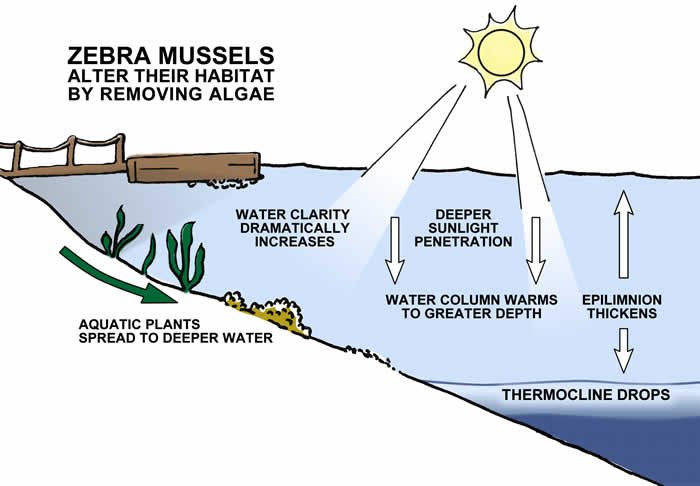Zebra Mussels in Missouri Lakes
Originally from the Black Sea region of Eastern Europe, zebra mussels first came to the United States via the ballast waters of ships visiting the Great Lakes. Zebra mussels are very prolific breeders, with adult females producing anywhere from 30,000 to 1.6 million eggs per year. The larval mussels (called veligers) can attach to nearly anything, including docks, boats, plants, people, crayfish and birds. Frequently the mussels attach to each other, which results in large colonies called druses. By forming druses, zebra mussel colonies can grow in three dimensions, not just two, allowing the number of mussels per square foot to skyrocket. One study found that zebra mussel densities at some Lake Michigan sites increased from an average of 14 mussels per square foot to between 5,000 and 25,000 mussels per square foot in just a single year.
The zebra mussel is a filter feeder, with each adult capable of clearing the algae from a quart of water each day. A thousand zebra mussels can thus filter 250 gallons of water each day. As the mussels filter algae out of the water, the water typically becomes considerably clearer. As they process the stuff they filter from the water, the zebra mussels deposit feces and pseudofeces (particles they capture, but can’t ingest) on the lake bottom. The result is that the organisms that rely on free-floating (planktonic) algae will suffer as their food supply is depleted, and bottom-feeding (benthic) organisms will thrive on the fallen scraps and feces deposited by the zebra mussels.
Over time, even fish communities may be altered. Zooplankton, a common food for larval fish, will suffer as their food source is consumed by the zebra mussel. Fish that dine on benthic invertebrates will do well, especially if they can eat zebra mussels directly. Freshwater drum, catfish, sunfish and lake sturgeon are able to feed upon zebra mussels, though not heavily enough to significantly decrease the numbers.
Increased water clarity (thanks to zebra mussel filtration) exposes more of the lake’s bottom to sunlight, resulting in more habitat for aquatic plants. As the quantity of vegetation increases, more nutrients will be taken out of the water column and be unavailable to algae. The increase in vegetation may be troubling to some lake users, as plants foul boat propellers and swimming areas. Additionally, zebra mussels attach quite readily to plants, so clearing the water can potentially increase the amount of surface area for zebra mussel attachment. More surface area means more zebra mussels and the cycle continues.
Another side effect of zebra mussel infestation is altered stratification. As the water becomes clearer, sunlight penetrates deeper into the water column, heating more water. Eventually, the oxygenated upper layer of water (epilimnion) becomes thicker. Since the cooler, bottom layer of water (hypolimnion) is often devoid of life-supporting oxygen, the result is a greater volume of “habitable” water.
Zebra mussels have arrived in Missouri. If the zebra mussels thrive in our lakes, then our lakes will change. Clearer water is often thought of as a good thing, but zebra mussels will displace our native mussels, alter habitat and food webs, and even change the stratification patterns in lakes. Ecologically speaking, zebra mussels don’t belong here. Nevertheless, they are here now and, unfortunately, they’re probably here to stay. With great effort and a little luck, we can keep them from spreading.
Missouri Lakes with zebra mussels:
Barber
Blue Springs
Bull Shoals
Jacomo
Lake of the Ozarks
Lotawana
Niangua
Smithville
Taneycomo
Truman
A Simple D.I.Y. Zebra Mussel Monitoring Tool
You can monitor for zebra mussels at your lake with this easy to make tool. Simply cut a 24 inch long piece of 4 inch PVC pipe and drill 2 holes at one end. Thread a rope through the holes and submerge the pipe vertically in a shady spot under your dock. Be sure to keep it about a foot off the bottom.
Pull the pipe up and check it occasionally throughout the summer. If you find any zebra mussels, contact your local Missouri Department of Conservation office as soon as possible.



